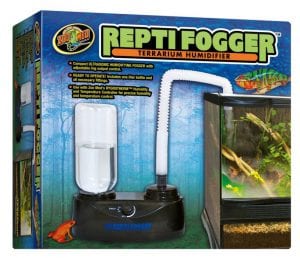I have been in the rainforests around the world several times over the years, studying and photographing animals. For anybody who hasn’t been there let me tell you that it is hot and humid – makes it very sticky and uncomfortable. It’s not only the areas that get hot, I have visited cloud forests where it is cool, and the humidity just hangs in the air. For the animals that live in these places, it is just normal to them, and such animals need that level of humidity if they are to thrive. When keeping the frogs and lizards (in particular) from those regions it is critical to maintain and correctly monitor the hight humidity levels. There are many ways a hobbyist can provide humidity – waterfalls, spraying the terrarium with a handheld sprayer, large water areas (perhaps with an air pump bubbler) etc. But by far the most accurate and easy are the various systems designed to fog or spray a terrarium. These can be very involving and look like you need qualifications in  plumbing to get working. Others are as simple as simple can be – there are pro’s and con’s to both, this article is for one of the simple, inexpensive foggers on the market – Zoo Med’s Repti-fogger.
plumbing to get working. Others are as simple as simple can be – there are pro’s and con’s to both, this article is for one of the simple, inexpensive foggers on the market – Zoo Med’s Repti-fogger.
Upon taking it out of its box it’s immediately obvious that it is not going to be complicated to set up, it has a base with rotary controls, mains power lead, a reservoir plastic bottle and a flexible pipe to go into the vivarium. I did have concerns as to how the water would stay in the bottle when reconnecting it to the base, but Zoo Med have thought of this with a “no spill valve”. It works fine there was a couple of drips and dribbles when turning the bottle upside down, but nothing to worry about. Other than that, the actual refitting of the reservoir bottle is easy, however it is quite small and will need filling quite regularly. I found on my set up it lasted around a day, maybe into the second day. It does have a built-in safety valve though, just in case it is allowed to run dry. This will shut the system down to stop the motor burning out. During my time using this unit I did find the safety valve would occasionally cause the system to not operate, there is a small white float that sometimes sticks. I found squeezing the bottle released it effectively, and all was good again. It didn’t happen often, and there is a light to indicate no water, this also came on to warn the float was stuck – useful for both occurrences.
Placing the system was a little awkward – it needs to be outside the vivarium, the flexi-pipe is quite long, but with the tall Zoo Med Paludarium I used I found it all quite restrictive. Maybe this is because I am used to the “plumb-in” systems such as those provided by MistKing? However, it’s worth mentioning as there are no extension pipes, plus I doubt the fan system that blows the mist up the pipe would be strong enough. Which leads me to the actual power of the unit. It is not particularly powerful. With the supplied pipe at full length the fan just about blows the mist into the vivarium, at shorter lengths its much more successful. For this reason I would suggest it is ideally suited for smaller terraria, maybe up to a maximum of 60cm, preferably less (unless the unit could be sat higher to the top of the vivarium). But then it is very keenly priced, powerful systems are much more – sometimes much, much more.
There is a rotary control to increase and decrease the amount of mist generated, which seems to work well. But for total automation I would suggest Zoo Med’s HygroTherm™ Humidity and Temperature Controller. All in all a relatively cheap and cheerful mist (fog) system, worked well enough, but won’t impress the more intense natural terrarium keeper.
